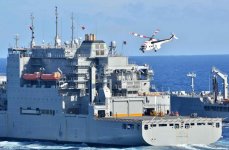- Reaction score
- 24,026
- Points
- 1,360
Chris Pook said:That way lies madness....
Next you will be proposing that other tasks in environments where bullets are not a risk factor could be civilianized - things like SAR, Air/Space Surveillance (Satellites and UAV), Maintenance, other Logistics.
Then the manning limit of 65,000 or whatever it currently is could be applied to uniformed personnel tasked with going into harm's way.
Madness indeed!
When first-world blue water Navies start contracting civilian helicopters in operational theatres to support their military sealift logistic support vessels, then we'll know that the end of the earth is coming!
Oh wait...


